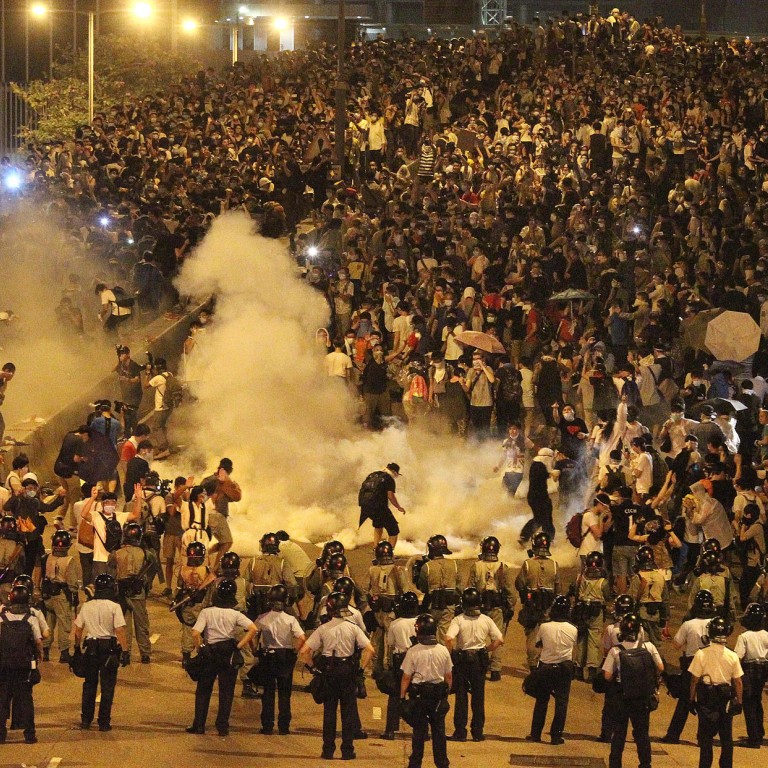
I've no regrets about the tear gas, says top police officer who ordered its use
Commander who made the decision believes it was the lesser of two evils as lives were at stake
The police officer who made the controversial call to use tear gas on thousands of Occupy Central demonstrators in Admiralty one week ago today, fuelling unprecedented civil disobedience in Hong Kong, says he has no regrets and would make the same decision again.
The senior superintendent was the commander in charge of the area where tear gas was fired last Sunday afternoon into crowds of pro-democracy supporters that had taken over a major street near government offices.
"I have no regrets. If I hadn't used it, and they had come through, we could have ended up with seriously injured or worse," he said, referring to a mass crush in 1992 in Lan Kwai Fong that left 21 people dead.
"If I am in the same situation [again], and there is serious threat to public safety, then I will do the same."
He said if he had not made the decision, people could have died, as the use of tear gas was solely to prevent mass injuries from a possible stampede if there had been a sudden break in the cordon.
Watch: Police fire tear gas at protesters outside Hong Kong government offices on Sep 28
"It wasn't intended to disperse the crowd ... it was intended to stop the charge and make sure there was no crush of people," he said.
After assessing the situation for several hours and when a group of about 200 protesters became more aggressive in trying to break the police cordon, he said he - and he alone - authorised the officers under his command to use tear gas on the protesters.
"The guys at the front, in the first three or four rows, were very aggressive in their actions towards police, poking umbrellas, kicking officers," he said last night in an interview with the at police headquarters in Wan Chai, where the nearby streets remained closed due to the protests.
"The use of CS [tear gas] was my decision. As a commander at scene at my rank, I am entitled to various options in terms of application of use of force and use of tear smoke, I am entitled to do that, so it's my decision.
"I hope people understand why it was used. It was used to ensure their safety. There was no political motive in this. It comes down to me as the commander on the ground, thinking people are getting seriously hurt and that was why it was done.
"I can appreciate it is very dramatic, CS grenade going up into the air, exploding ... coming down, pumping out smoke but the alternative would have been far worse, if we'd had 30 people going to hospital with broken bones, broken arms, gashes on their legs.
After the interview was conducted, police asked that the officer's name not be disclosed.
The officer said instead of tear gas, he could have ordered the officers under his command to launch a coordinated baton attack on the protesters.
"There is a misconception that somehow the use of a baton is a degree of force below the use of CS," he said.
"If we tried to move them using strikes with batons, that would cause lots of injuries - lacerations, broken bones, at the very least swelling and bruising. No one's actually injured by the use of CS ... Nobody dies from CS smoke. It's not pleasant but no one was injured."
He described his call as a successful one. "They backed straight off the barriers about 20 to 30 feet which gave us time to re-set the line, get everyone back into position," the senior superintendent said.
He said images of families and children surrounded by tear gas were "very unfortunate" but that use of tear gas "was necessary to maintain order".
With 26 years' experience in the force, he said he regarded himself as a Hongkonger.
He said once he made the decision, he had to call for supplies of the gas to be delivered. "I didn't actually have the CS with me at the time because normally in Hong Kong, things are very peaceful. So I had to ask for the CS to be delivered and that took about 15 minutes in which time there was vigorous pushing and shoving.
"In requesting the supplies, I was also reminded that, 'OK, it's your authority, your decision; however, make sure people are verbally and visually warned', so I did that as well. That was the only additional instruction from above my rank."
Asked if Chief Executive Leung Chun-ying had to be notified of his decision, the officer said no.
"It was never about an offensive action, it was about defending the line and making sure there wasn't this crush of people."
In the immediate hours after the tear gas was used, thousands of people joined the protests, galvanised by what they felt was a heavy-handed reaction to peaceful activists, and images of the chaotic scenes were broadcast across the globe.
"It's a shame those images are out there because this is a safe place. Crime is low, violence is low, people protest in a peaceful manner; it's just these few elements.
"I'm aware that the pictures themselves have a negative impact but I'm not going to regret that decision.
"It was the correct decision. It was my job to make that decision," he added.
The 47-year-old said his wife had taken their two young children, aged 10 and eight, to the protest site in Admiralty, "just to have a look and explain to them what was going on", he said.

